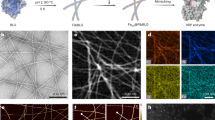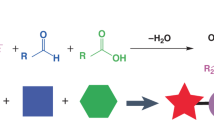Abstract
Hydrogelators are small, self-assembling molecules that form supramolecular nanofiber networks that exhibit unique dynamic properties. Development of supramolecular hydrogels that degrade in response to various biomolecules could potentially be used for applications in areas such as drug delivery and diagnostics. Here we provide a synthetic procedure for preparing redox-responsive supramolecular hydrogelators that are used to create hydrogels that degrade in response to oxidizing or reducing conditions. The synthesis takes ∼2–4 d, and it can potentially be carried out in parallel to prepare multiple hydrogelator candidates. This described solid-phase peptide synthesis protocol can be used to produce previously described hydrogelators or to construct a focused molecular library to efficiently discover and optimize new hydrogelators. In addition, we describe the preparation of redox-responsive supramolecular hydrogel–enzyme hybrids that are created by mixing aqueous solutions of hydrogelators and enzymes, which requires 2 h for completion. The resultant supramolecular hydrogel–enzyme hybrids exhibit gel degradation in response to various biomolecules, and can be rationally designed by connecting the chemical reactions of the hydrogelators with enzymatic reactions. Gel degradation in response to biomolecules as triggers occurs within a few hours. We also describe the preparation of hydrogel–enzyme hybrids arrayed on flat glass slides, enabling high-throughput analysis of biomolecules such as glucose, uric acid, lactate and so on by gel degradation, which is detectable by the naked eye. The protocol requires ∼6 h to prepare the hydrogel–enzyme hybrid array and to complete the biomolecule assay.
This is a preview of subscription content, access via your institution
Access options
Subscribe to this journal
Receive 12 print issues and online access
$259.00 per year
only $21.58 per issue
Buy this article
- Purchase on Springer Link
- Instant access to full article PDF
Prices may be subject to local taxes which are calculated during checkout








Similar content being viewed by others
References
Tu, Y. et al. Mimicking the cell: bio-inspired functions of supramolecular assemblies. Chem. Rev. 116, 2023–2078 (2016).
Burdick, J.A. & Murphy, W.L. Moving from static to dynamic complexity in hydrogel design. Nat. Commun. 3, 1269 (2012).
Estroff, L.A. & Hamilton, A.D. Water gelation by small organic molecules. Chem. Rev. 104, 1201–1217 (2004).
de Loos, M., Feringa, B.L. & van Esch, J.H. Design and application of self-assembled low molecular weight hydrogels. Eur. J. Org. Chem. 2005, 3615–3631 (2005).
Hirst, A.R., Escuder, B., Miravet, J.F. & Smith, D.K. High-tech applications of self-assembling supramolecular nanostructured gel-phase materials: from regenerative medicine to electronic devices. Angew. Chem. Int. Ed. 47, 8002–8018 (2008).
Du, X., Zhou, J., Shi, J. & Xu, B. Supramolecular hydrogelators and hydrogels: from soft matter to molecular biomaterials. Chem. Rev. 115, 13165–13307 (2015).
Dasgupta, A., Mondal, J.H. & Das, D. Peptide hydrogels. RSC Adv. 3, 9117–9149 (2013).
Ryan, D.M. & Nilsson, B.L. Self-assembled amino acids and dipeptides as noncovalent hydrogels for tissue engineering. Polym. Chem. 3, 18–33 (2012).
Segarra-Maset, M.D., Nebot, V.J., Miravet, J.F. & Escuder, B. Control of molecular gelation by chemical stimuli. Chem. Soc. Rev. 42, 7086–7098 (2013).
Yang, Z., Liang, G. & Xu, B. Enzymatic control of the self-assembly of small molecules: a new way to generate supramolecular hydrogels. Soft Matter 3, 515–520 (2007).
Ulijn, R.V. Enzyme-responsive materials: a new class of smart biomaterials. J. Mater. Chem. 16, 2217–2225 (2006).
Sáez, J.A., Escuder, B. & Miravet, J.F. Supramolecular hydrogels for enzymatically triggered self-immolative drug delivery. Tetrahedron 66, 2614–2618 (2010).
Shigemitsu, H. & Hamachi, I. Supramolecular assemblies responsive to biomolecules toward biological applications. Chem. Asian J. 10, 2026–2038 (2015).
Holtz, J.H. & Asher, S.A. Polymerized colloidal crystal hydrogel films as intelligent chemical sensing materials. Nature 389, 829–832 (1997).
Gajanayake, T. et al. A single localized dose of enzyme-responsive hydrogel improves long-term survival of a vascularized composite allograft. Sci. Transl. Med. 6, 249ra110 (2014).
Zhang, S. et al. An inflammation-targeting hydrogel for local drug delivery in inflammatory bowel disease. Sci. Transl. Med. 7, 300ra128 (2015).
Lutolf, M.P. et al. Repair of bone defects using synthetic mimetics of collagenous extracellular matrices. Nat. Biotechnol. 21, 513–518 (2003).
Silva, G.A. et al. Selective differentiation of neural progenitor cells by high-epitope density nanofibers. Science 303, 1352–1355 (2004).
Haines-Butterick, L. et al. Controlling hydrogelation kinetics by peptide design for three-dimensional encapsulation and injectable delivery of cells. Proc. Natl Acad. Sci. USA 104, 7791–7796 (2007).
Ikeda, M., Tanida, T., Yoshii, T. & Hamachi, I. Rational molecular design of stimulus-responsive supramolecular hydrogels based on dipeptides. Adv. Mater. 23, 2819–2822 (2011).
Ikeda, M. et al. Installing logic-gate responses to a variety of biological substances in supramolecular hydrogel-enzyme hybrids. Nat. Chem. 6, 511–518 (2014).
Yoshii, T., Ikeda, M. & Hamachi, I. Two-photon-responsive supramolecular hydrogel for controlling materials motion in micrometer space. Angew. Chem. Int. Ed. 53, 7264–7267 (2014).
Yoshii, T., Onogi, S., Shigemitsu, H. & Hamachi, I. Chemically reactive supramolecular hydrogel coupled with a signal amplification system for enhanced analyte sensitivity. J. Am. Chem. Soc. 137, 3360–3365 (2015).
Jayawarna, V. et al. Nanostructured hydrogels for three-dimensional cell culture through self-assembly of fluorenylmethoxycarbonyl–dipeptides. Adv. Mater. 18, 611–614 (2006).
Mahler, A., Reches, M., Rechter, M., Cohen, S. & Gazit, E. Rigid, self-assembled hydrogel composed of a modified aromatic dipeptide. Adv. Mater. 18, 1365–1370 (2006).
Frederix, P.W.J.M. et al. Exploring the sequence space for (tri-)peptide self-assembly to design and discover new hydrogels. Nat. Chem. 7, 30–37 (2015).
Ryan, D.M., Doran, T.M., Anderson, S.B. & Nilsson, B.L. Effect of C-terminal modification on the self-assembly and hydrogelation of fluorinated Fmoc-phe derivatives. Langmuir 27, 4029–4039 (2011).
Buerkle, L.E., Li, Z., Jamieson, A.M. & Rowan, S.J. Tailoring the properties of guanosine-based supramolecular hydrogels. Langmuir 25, 8833–8840 (2009).
Ryan, D.M., Anderson, S.B. & Nilsson, B.L. The influence of side-chain halogenation on the self-assembly and hydrogelation of Fmoc-phenylalanine derivatives. Soft Matter 6, 3220–3231 (2010).
Bertolani, A. et al. Supramolecular amplification of amyloid self-assembly by iodination. Nat. Commun. 6, 7574 (2015).
Chen, L., Revel, S., Morris, K., Serpell, L.C. & Adams, D.J. Effect of molecular structure on the properties of naphthalenedipeptide hydrogelators. Langmuir 26, 13466–13471 (2010).
Wang, H. et al. A structure–gelation ability study in a short peptide-based 'Super Hydrogelator' system. Soft Matter 7, 3897–3905 (2011).
Sella, E. & Shabat, D. Dendritic chain reaction. J. Am. Chem. Soc. 131, 9934–9936 (2009).
Roth, M.E., Green, O., Gnaim, S. & Shabat, D. D, oligomeric, and polymeric self-immolative molecular amplification. Chem. Rev. 116, 1309–1352 (2015).
Weingarten, A.S. et al. Self-assembling hydrogel scaffolds for photocatalytic hydrogen production. Nat. Chem. 6, 964–970 (2014).
Wang, Q. et al. A supramolecular-hydrogel-encapsulated hemin as an artificial enzyme to mimic peroxidase. Angew. Chem. Int. Ed. 46, 4285–4289 (2007).
Yoshimura, I. et al. Molecular recognition in a supramolecular hydrogel to afford a semi-wet sensor chip. J. Am. Chem. Soc. 126, 12204–12205 (2004).
Ikeda, M., Ochi, R. & Hamachi, I. Supramolecular hydrogel-based protein and chemosensor array. Lab Chip 10, 3325–3334 (2010).
Kiriya, D. et al. Meter-long and robust supramolecular strands encapsulated in hydrogel jackets. Angew. Chem. Int. Ed. 51, 1553–1557 (2012).
Cornwell, D.J. & Smith, D.K. Expanding the scope of gels – combining polymers with low-molecular-weight gelators to yield modified self-assembling smart materials with high-tech applications. Mater. Horiz. 2, 279–293 (2015).
Heeres, A. et al. Orthogonal self-assembly of low molecular weight hydrogelators and surfactants. J. Am. Chem. Soc. 125, 14252–14253 (2003).
Brizard, A. et al. Preparation of nanostructures by orthogonal self-assembly of hydrogelators and surfactants. Angew. Chem. Int. Ed. 47, 2063–2066 (2008).
Wickremasinghe, N.C., Kumar, V.A., Shi, S. & Hartgerink, J.D. Controlled angiogenesis in peptide nanofiber composite hydrogels. ACS Biomater. Sci. Eng. 1, 845–854 (2015).
Patil, A.J., Kumar, R.K., Barron, N.J. & Mann, S. Cerium oxide nanoparticle-mediated self-assembly of hybrid supramolecular hydrogels. Chem. Commun. 48, 7934–7936 (2012).
Wada, A., Tamaru, S.-I., Ikeda, M. & Hamachi, I. MCM-enzyme-supramolecular hydrogel hybrid as a fluorescence sensing material for polyanions of biological significance. J. Am. Chem. Soc. 131, 5321–5330 (2009).
Ikeda, M. et al. Montmorillonite-supramolecular hydrogel hybrid for fluorocolorimetric sensing of polyamines. J. Am. Chem. Soc. 133, 1670–1673 (2011).
Kiyonaka, S. et al. Semi-wet peptide/protein array using supramolecular hydrogel. Nat. Mater. 3, 58–64 (2004).
Guler, M.O., Pokorski, J.K., Appella, D.H. & Stupp, S.I. Enhanced oligonucleotide binding to self-assembled nanofibers. Bioconjugate Chem. 16, 501–503 (2005).
Patil, S.P., Jeong, H.S. & Kim, B.H. A low-molecular-weight supramolecular hydrogel of riboflavin bolaamphiphile for VEGF-siRNA delivery. Chem. Commun. 48, 8901–8903 (2012).
Poolman, J.M. et al. Variable gelation time and stiffness of low-molecular-weight hydrogels through catalytic control over self-assembly. Nat. Protoc. 9, 977–988 (2014).
Chan, W.C. & White, P.D. Fmoc Solid Peptide Synthesis (Oxford University Press, New York, 2000).
Slavici, T., Darvasi, D., Mnerie, A. & Cechin-Crista, P. Development of economical and efficient mixed reactive carbonates for peptide synthesis through scientific planning. Rev. Chim. 64, 425–429 (2013).
Raeburn, J., Zamith Cardoso, A. & Adams, D.J. The importance of the self-assembly process to control mechanical properties of low molecular weight hydrogels. Chem. Soc. Rev. 42, 5143–5156 (2013).
Morris, K.L. et al. Chemically programmed self-sorting of gelator networks. Nat. Commun. 4, 1480 (2013).
Komatsu, H. et al. Supramolecular hydrogel exhibiting four basic logic gate functions to fine-tune substance release. J. Am. Chem. Soc. 131, 5580–5585 (2009).
Acknowledgements
We gratefully acknowledge the financial support from the CREST program of the JST.
Author information
Authors and Affiliations
Contributions
H.S., T.F., S.O. and T.Y. performed the experiments and analyzed the data; H.S., T.Y., M.I. and I.H. designed the experiments; and H.S., M.I. and I.H. wrote the paper. All authors contributed to discussion of results and editing of the manuscript.
Corresponding authors
Ethics declarations
Competing interests
The authors declare no competing financial interests.
Integrated supplementary information
Supplementary Figure 1 Gelation tests of NPmoc-FF derivatives (NPmoc-F(4-R1)F(4-R2)).
Photographs showing the gelation ability of NPmoc-FF derivatives (NPmoc-F(4-R1)F(4-R2)). Conditions: 200 mM MES (pH 7.0), 37 ºC.
Supplementary information
Supplementary Text and Figures
Supplementary Figure 1 (PDF 243 kb)
The method for the preparation of GOx-encapsulating supramolecular gels (GOx⊂BPmoc-FFF hybrid gels) in a screw vial and their glucose-responsive gel degradation.
Conditions: [BPmoc-FFF] = 0.15 wt% (100 mM MES (pH 7.0), 100 μl), [GOx] = 50 mg/mL (10 mM HEPES (pH 7.0), 1 μL). (MP4 6305 kb)
The method for the preparation of enzymes (GOx, SOx, UOx and COx) encapsulating supramolecular gels (GOx, Sox, UOx or COx ⊂BPmoc-FFF hybrid gels) and checking of gel–sol transitions on a glass slide.
In the video, we added glucose solution to the gels. The GOx-encapsulating supramolecular gel (GOx⊂BPmoc-FFF hybrid gel) changed to a sol >4 h from the addition of aqueous glucose solution (1 μl, 24 mM). The corresponding spot was easily washed off by water. Conditions: [BPmoc-FFF] = 0.15 wt% (100 mM MES (pH 7.0), 10 μl), [GOx] = 2.7 μM, [SOx] = 6.7 μM, [UOx] = 3.6 μM, [COx] = 4.6 μM (10 mM HEPES (pH 7.0), 0.5 μl). (MP4 5070 kb)
Rights and permissions
About this article
Cite this article
Shigemitsu, H., Fujisaku, T., Onogi, S. et al. Preparation of supramolecular hydrogel–enzyme hybrids exhibiting biomolecule-responsive gel degradation. Nat Protoc 11, 1744–1756 (2016). https://doi.org/10.1038/nprot.2016.099
Published:
Issue Date:
DOI: https://doi.org/10.1038/nprot.2016.099
This article is cited by
-
Stimuli-responsive supramolecular systems guided by chemical reactions
Polymer Journal (2019)
-
An adaptive supramolecular hydrogel comprising self-sorting double nanofibre networks
Nature Nanotechnology (2018)
-
Modular DNA strand-displacement controllers for directing material expansion
Nature Communications (2018)
Comments
By submitting a comment you agree to abide by our Terms and Community Guidelines. If you find something abusive or that does not comply with our terms or guidelines please flag it as inappropriate.



